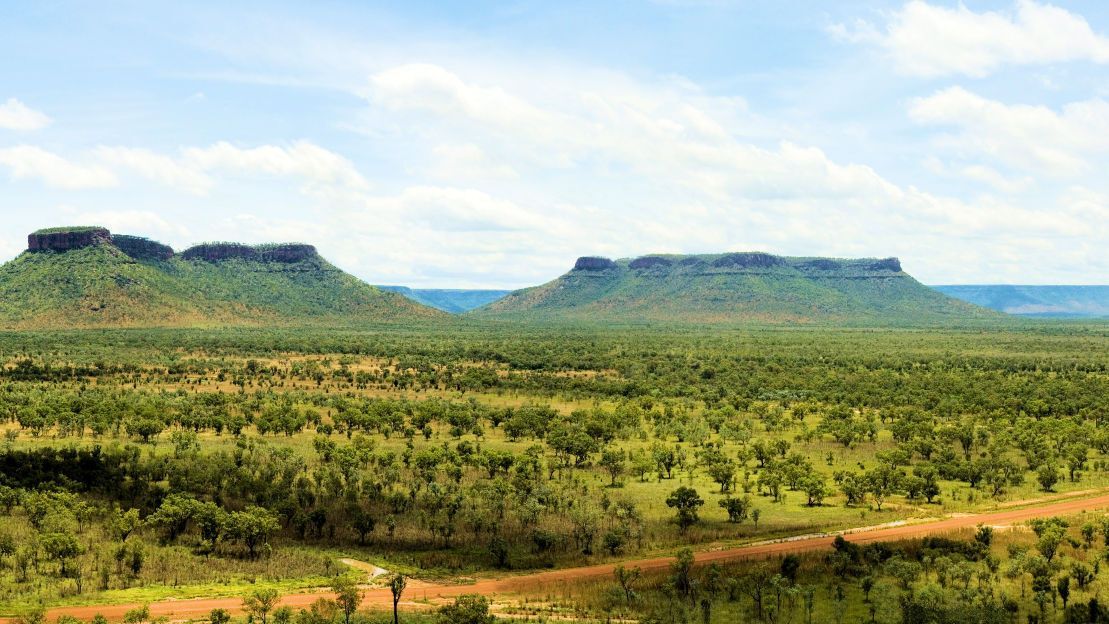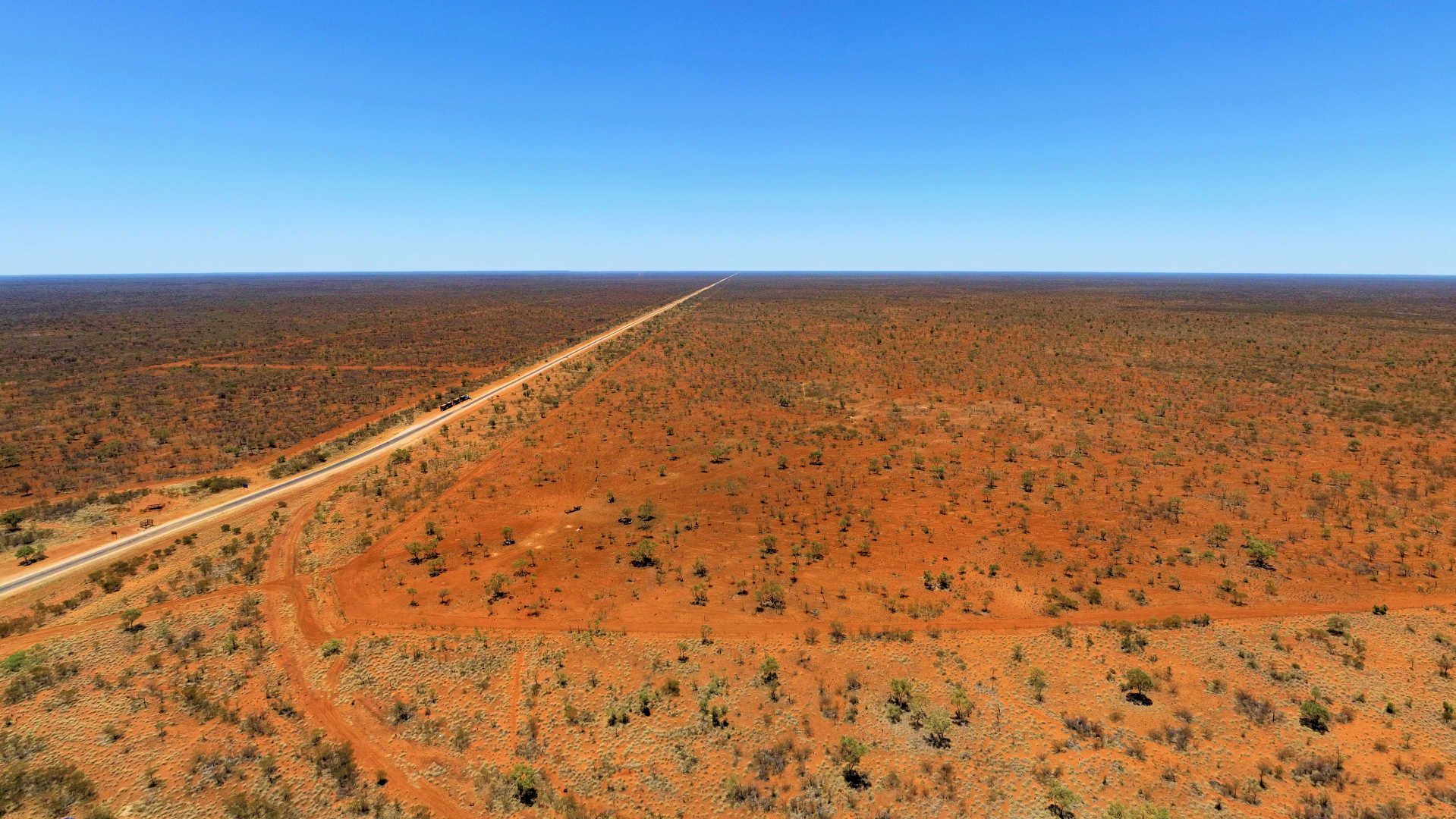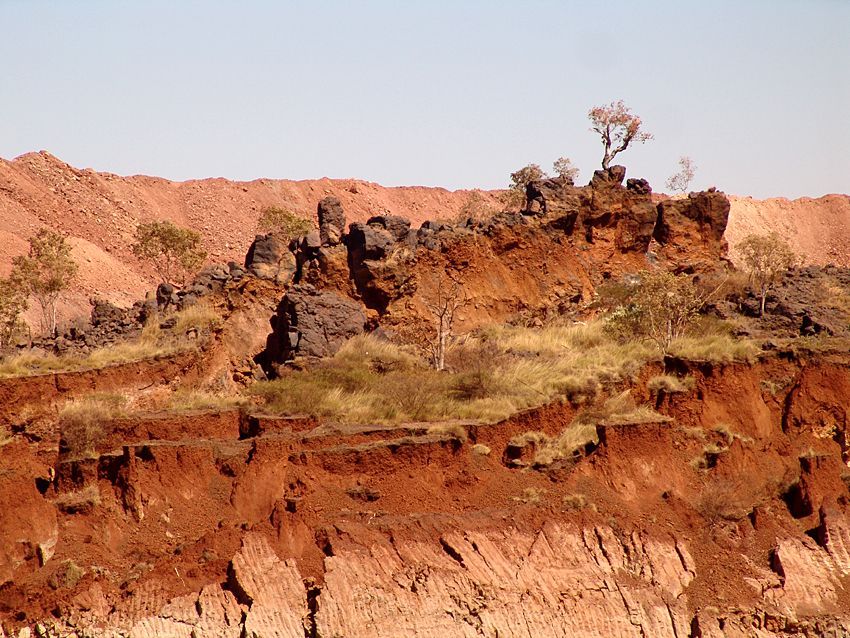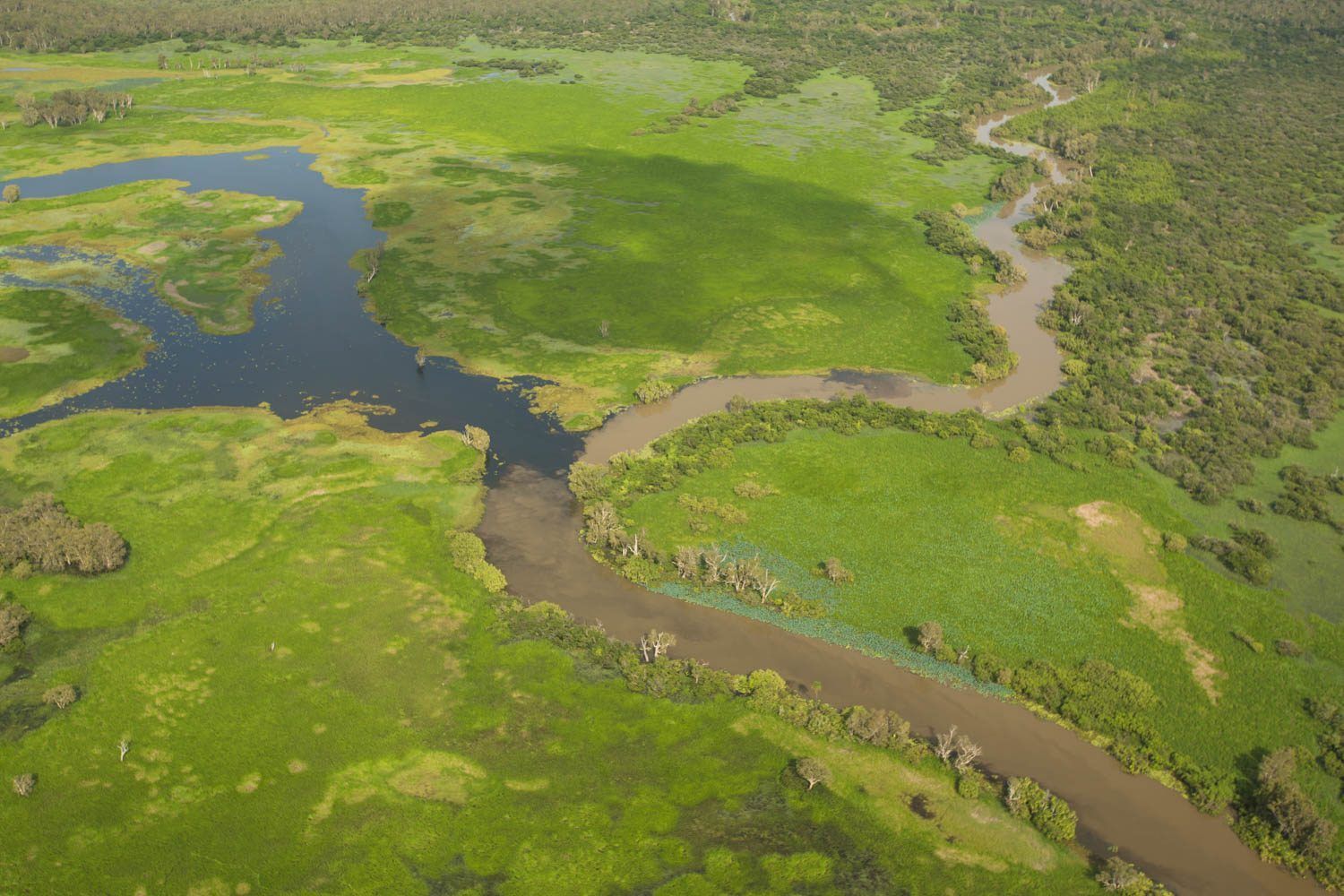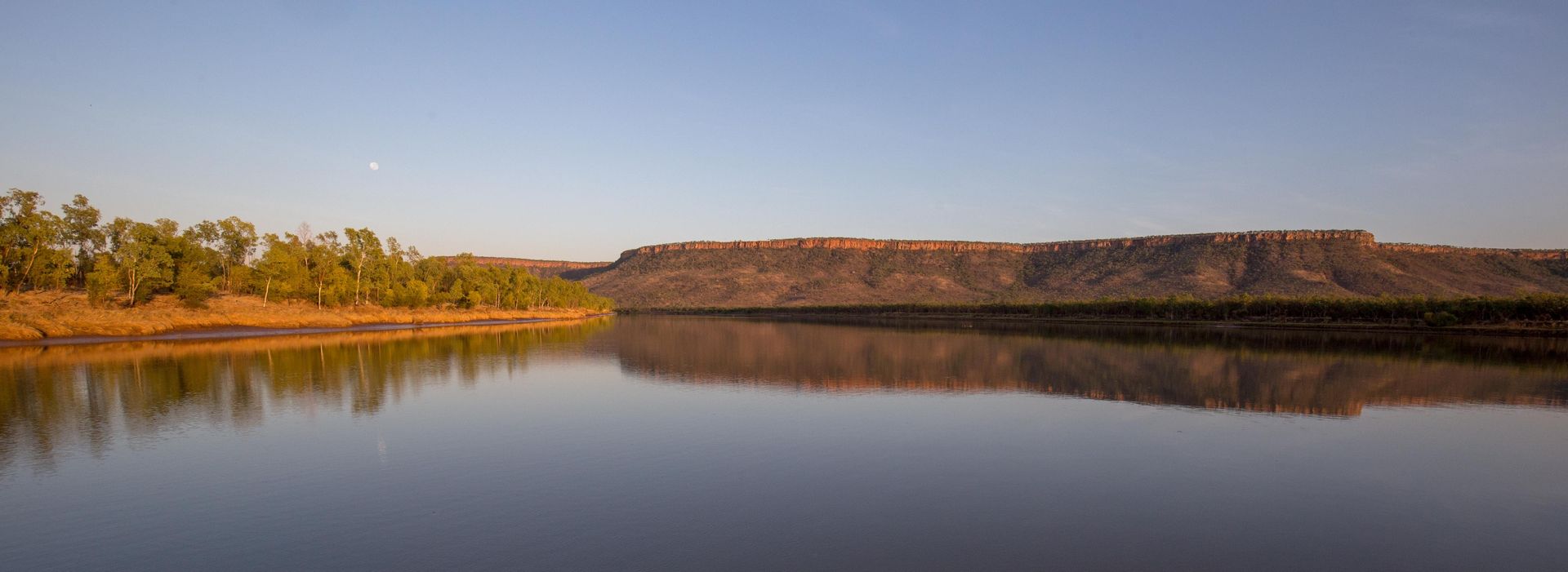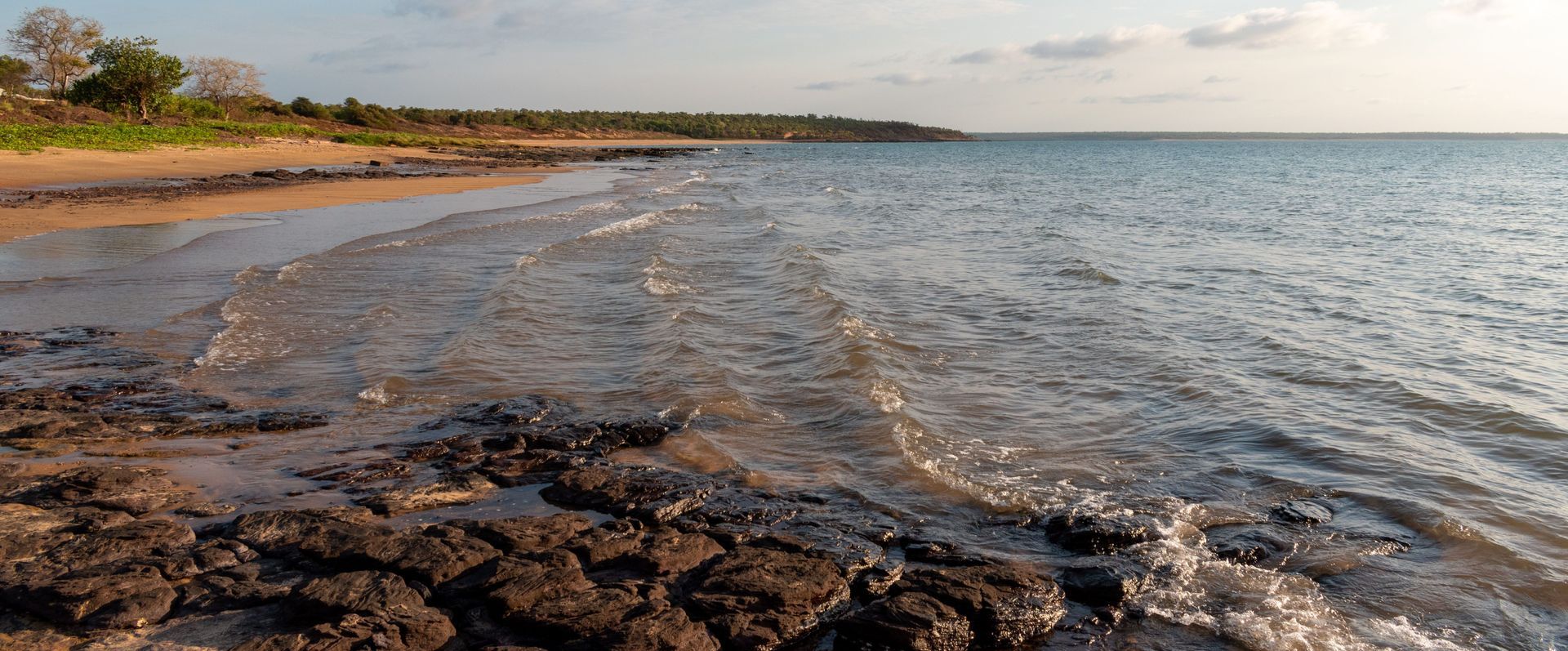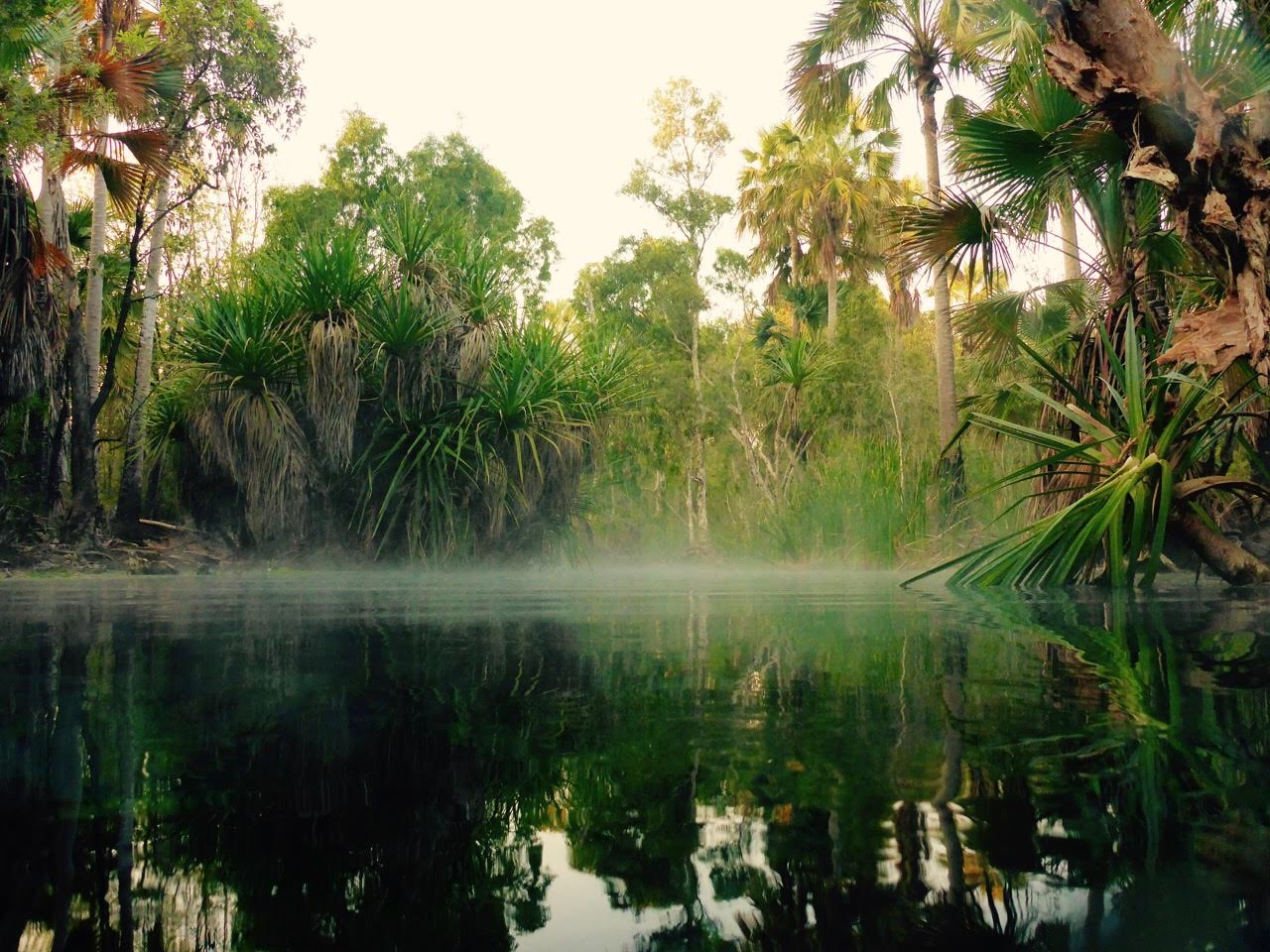Access Permits

Commonwealth and Northern Territory law says that entry to Aboriginal land requires a written permit. The NLC is responsible for administering the permit system for traditional owners in the Top End.
Please note that we recommend using Microsoft Edge, Safari, Firefox or Chrome for the best experience and security with the NLC permit system. User interface issues may occur when using Internet Explorer.
The NLC permit system is designed to be easy to use for applicants. It helps protect the privacy of Aboriginal communities, preserve Aboriginal culture, safeguard the natural environment and promote visitor safety and amenity.
Aboriginal people have the legal right to grant or refuse permission to people wishing to enter or travel through their land. Some people with specific roles have an exemption or a defence while they are working in that role on Aboriginal land.
You need to apply to the NLC for a permit if you wish to undertake any of the following activities on Aboriginal land in the NLC's area:
- Enter Aboriginal land or waters for any purpose
- Travel by private road on Aboriginal land
- Enter or visit an Aboriginal Community
How to Apply
You can now manage your permits online. We encourage you to register for the NLC permit system. This will make your permit process faster and more efficient. For guidelines on how to use the Permit Administration System (PAS) see link below.
Recreation applications are temporarily unavailable online. For special circumstances, please download the permit application pack from the NLC website.
Permit application process
Your application for an NLC permit must specify the purpose of your visit, the dates, places and access routes, and your vehicles, passengers and accommodation. The NLC will consider your application and seek approval from relevant Traditional Owners.
Please allow up to 10 days for processing and contact us about access restrictions during the Covid-19 pandemic. If we require additional time to consider your application, we will let you know, eg complex applications, such as some research and media applications.
Permit contact centre
If you have any questions about the system or the application process, please use our contact centre to record your query and an NLC staff member will get in touch as soon as possible. You can use the contact centre without being logged-in. Otherwise, email us at permits@nlc.org.au or call 1800 645 299.
Temporary Closures
Closures for cultural reasons, such as funerals and ceremonies, do occur at short notice. Please respect these cultural traditions. We will send an email and/or text message to relevant permit holders about any closures that occur in their permitted areas. Please keep your contact details up to date.
Permit Types
| PERMIT TYPE | DESCRIPTION |
|---|---|
| Work | Work types include general, essential, mining, tourism (under a s19 agreement), research and media. Applicants for work permits need to provide their purpose, locations and time frame of their work. |
| Visitor | Permit holders who have been invited to visit friends or family living in an Aboriginal community. |
| Recreation | Permit holders can access recreation areas on Aboriginal land for recreation purposes. |
| Recreational Fishing | Permit holders can access specific recreational fishing zones on Aboriginal land for the purpose of fishing during the dates listed on their permit. |
| Transit | Permit holders can access specific private roads on Aboriginal land during the dates listed on their permit. |
| Residential | Permit holders can reside on Aboriginal land, usually in a community, but also in a workers' camp, and commercial or staff accommodation. |
Entry Without a Permit
Unauthorised entry could result in a fine of 50 penalty units (currently $11,100) under Commonwealth law, or 8 penalty units (currently $1,264) under Northern Territory law. The acceptance of insurance claims on Aboriginal land may rely on a valid permit.
FAQs: Permits
Work Permit
To apply for a Work Permit you need to provide the purpose of your work and the locations, time periods and work type. Work type include:
- General
- Essential activity
- Mining
- Tourism
- Media (see extra information below)
- Research (see extra information below)
Mining and Tourism Permits are issued to organisations with existing NLC Land Use Agreements or applications for a Land Use Agreement.
Who can apply?
- People who want to access Aboriginal land for work purposes
- Mining companies sending staff to work sites
- Lessees and licensees, i.e. businesses, government and non-government organisations with a Land Use Agreement, who are sending staff, contractors or agents to Aboriginal land for work purposes
- Contractors and sub-contractors undertaking work on Land Use Agreement areas
- Tour group operators taking tourists on organised tours on Aboriginal land including intertidal waters
- People and organisations wanting to undertake research on Aboriginal land
- Journalists and bloggers who want to access Aboriginal land to write stories or news items
- Photographers and filmmakers wanting to make visual or audio recordings on Aboriginal land
- Anyone who wants to access Aboriginal land for business development, commercial research and development, or business negotiations
How to apply?
You can now manage your permits online. We encourage you to register for the NLC permit system. This will make your permit process faster and more efficient. To apply for a Work Permit:
For guidelines on how to use the Permit Administration System (PAS) see link below.
Application Process
Your application for a NLC permit must specify the purpose of your visit, the dates, places and access routes, and your vehicles, passengers and accommodation. The NLC will consider your application and seek approval from relevant traditional Aboriginal owners.
Please allow up to 10 days for processing and contact us about access restrictions during the Covid-19 pandemic. If we require additional time to consider your application, we will let you know, eg complex applications, such as some research and media applications.
Media Permits
While Aboriginal land is privately owned, Aboriginal people recognise that it is important for media professionals to have access to their communities as long as cultural sensitivities (e.g. sacred sites, periods of mourning) are respected and appropriate behaviour is observed.
Applicants involved in commercial projects, such as films, documentaries or books, are advised that the NLC requires significant advanced notice to process an application. If the project is likely to involve a significant impact on Aboriginal people’s privacy and property, additional notice may be required to allow time for all relevant Traditional Owners to be consulted. In many instances, an application will cover a geographical area involving a number of different Traditional Owners and each must be consulted.
Please download the Supplementary Form below and upload it as part of your application. In the application portal select Work as the Permit Type and then Media as the work type.
Research Permits
People and organisations wanting to undertake research or conduct surveys on Aboriginal land are required to provide detailed information before a permit can be considered. Please include the nature of the research, the methodology, proposed publication details and the benefits to the traditional owners. The information you provide will be presented to relevant Traditional Owners and their resulting directions will be conveyed back to you.
Please download these forms:
To apply for a research permit select Work as the Permit Type and Research as the work type.
FAQs: Work Permit
Visitor Permit
You may apply for a Visitor Permit if you have been invited to stay with a community resident for the purpose of visiting family or friends, attending a funeral or other community event.
Overnight visitors must nominate their place of accommodation and should reside there. Applicants should provide the name and contact details of the community resident they plan to stay with.
Visitors should abide by the community’s alcohol restrictions and as a guest of the community, visitors should obey all instructions from traditional Aboriginal owners while in the community.
If you want to carry out recreational activities on Aboriginal land outside the specified Aboriginal community, you will need a Recreation Permit as well as your Visitor Permit.
Who can apply?
Anyone who has been invited by a community resident to visit family or friends or attend community events.
How to apply?
You can now manage your permits online. We encourage you to register for the NLC permit system. This will make your permit process faster and more efficient. To apply for an NLC permit:
For guidelines on how to use the Permit Administration System (PAS) see link below.
Application Process
Your application for an NLC permit must specify the purpose of your visit, the dates, places and access routes, and your vehicles, passengers and accommodation. The NLC will consider your application and seek approval from relevant traditional Aboriginal owners.
Please allow up to 10 days for processing and contact us about access restrictions during the Covid-19 pandemic.
Permit Contact Centre
If you have any questions about the system or the application process, please use our
contact centre
to record your query and an NLC staff member will get in touch as soon as possible. You can use the contact centre without being logged-in. Otherwise, email us at
permits@nlc.org.au, call
1800 645 299, or contact an NLC Regional Office for local advice.
Entry Without a Permit
Unauthorised entry could result in a fine of 50 penalty units (currently $11,100) under Commonwealth law or 8 penalty units (currently $1,264) under Northern Territory law. The acceptance of insurance claims on Aboriginal land may rely on a valid permit.
Recreation Permit
You may apply for a Recreation Permit to access recreation areas on Aboriginal land for recreation purposes.
Traditional Owners have identified a number of recreation areas on Aboriginal land. Each site has rules on visitor numbers and the length of stay. Some sites allow activities, such as camping. Permit holders can access private roads during the specific dates listed on their permit. Stopping is only permitted in certain locations along transit routes. If staying overnight in a community, applicants must provide accommodation details.
Who can apply?
- Anyone wanting to camp at designated recreation sites on Aboriginal land
- Anyone wanting to go fishing on non-tidal waters on Aboriginal Land
- Anyone wanting to use a private road on Aboriginal land for recreational purposes
- Anyone visiting an art centre or other recreational attractions on Aboriginal land
- Anyone who holds a Work or Residential Permit and wants to carry out recreational activities on Aboriginal land outside work commitments
- Anyone who holds a Transit Permit and wants to carry out recreational activities on Aboriginal land
- Anyone who holds a Visitor Permit and wants to carry out recreational activities on Aboriginal land outside the Aboriginal community specified in their Visitor Permit
How to apply?
You can now manage your permits online. We encourage you to register for the NLC permit system. This will make your permit process faster and more efficient. To apply for an NLC permit:
For guidelines on how to use the Permit Administration System (PAS) see link below.
Application Process
Your application for a NLC permit must specify the purpose of your visit, the dates, places and access routes, and your vehicles, passengers and accommodation. The NLC will consider your application and seek approval from relevant traditional Aboriginal owners. Please allow up to 10 days for processing and contact us about access restrictions during the Covid-19 pandemic.
Permit contact centre
If you have any questions about the system or the application process, please use our contact centre to record your query and an NLC staff member will get in touch as soon as possible. You can use the contact centre without being logged-in. Otherwise email us at permits@nlc.org.au, call 1800 645 299 or contact an NLC Regional Office.
Entry without a permit
Unauthorised entry could result in a fine of 50 penalty units (currently $11,100) under Commonwealth law or 8 penalty units (currently $1,264) under Northern Territory law. The acceptance of insurance claims on Aboriginal land may rely on a valid permit.
FAQs: Recreation Permit
Recreational Fishing
Recreational fishing is a popular activity in the Northern Territory and occurs in various waters including Aboriginal waters. The term ‘Aboriginal waters’ refers to waters overlying Aboriginal land.
Permission is required to enter Aboriginal Land and Waters, including for recreational fishing. Permission to fish in Aboriginal Waters is provided via Recreational Fishing Permits administered by the NLC. The details and processing of these permits may vary per zone.
If you're planning a fishing trip in the Northern Territory, make sure to check the Recreational Fishing Aboriginal Waters Access Map for a general overview, and refer to specific zone maps found below for further information before applying for your permit.
The information below outlines access arrangements for recreational fishers who would like to access Aboriginal waters as of 10 April 2024.
Green Zones
No permit required
Recreational fishers who would like to access Aboriginal Waters marked in green on the Recreational Fishing Aboriginal Waters Access Map are able to do so without the need to apply for a Recreational Fishing Permit.
You are able to access these waters without a permit because the Traditional Aboriginal Owners of these areas have entered into an access agreement with the Northern Territory Government.
Black, Blue and Purple Zones
Permit required
Recreational fishers who wish to access Aboriginal waters marked in black, blue, or purple on the Recreational Fishing Aboriginal Waters Access Map must apply for a Recreational Fishing Permit.
Please note:
- The black, blue, and purple colours are used solely to identify different fishing zones. They do not have any additional significance.
- The permit application system allows you to select the specific zone and date range for your fishing trip.
- The length of access, process, and requirements may vary depending on the zone. Please see below specific zone maps for further detail.
Red Areas
Recreational fishers are not allowed to access Aboriginal Waters marked in red on the Recreational Fishing Aboriginal Waters Access Map. Please refer to specific zone maps for further information.
Recreational fishing access is prohibited in the following locations:
- Along the Finniss coast and the Peron Islands area (including the Little Finniss) – Zone 3
- The Mini Mini system, creeks and coastline down to an area just north of the mouth of the East Alligator River (including Saltwater Creek and Murgenella Creek) – Zone 4
Aboriginal Waters Access Map - Recreational Fishing
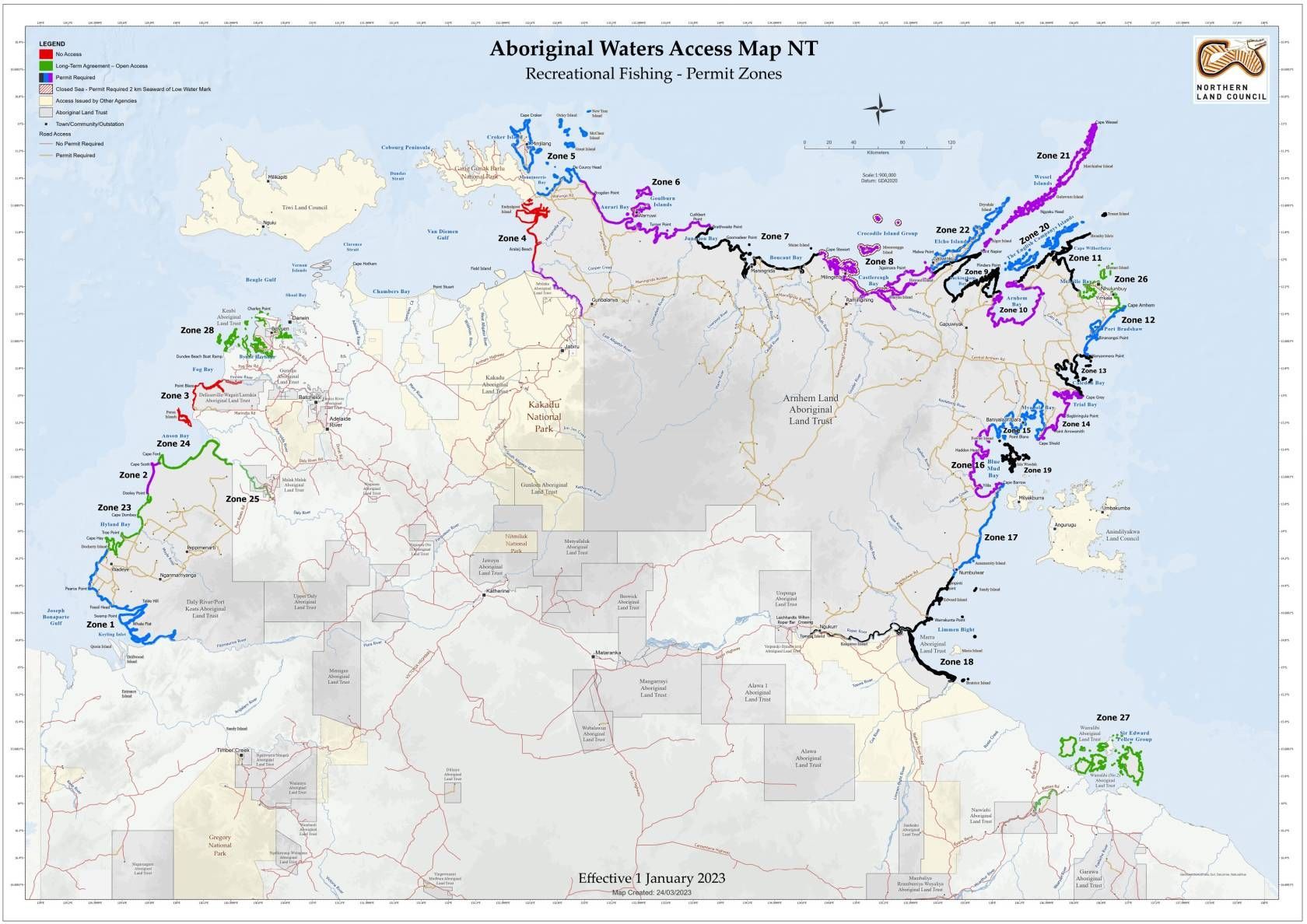
Unauthorised entry onto Aboriginal land and waters could result in a fine of 50 penalty units (currently $15,650) under Commonwealth law, or 8 penalty units (currently $1,408) under Northern Territory law. The acceptance of insurance claims on Aboriginal land may also rely on a valid permit.
Please contact Darwin Head Office at reception@nlc.org.au or (08) 8920 5100. If you would like any further information, please contact the Sea Country team at seacountry@nlc.org.au or (08) 8980 1925
This information was updated on 10 April 2024
Aboriginal Waters Access Maps
Zone maps for recreational fishing
Information updated on 10 April 2024
Zone 1
Download MapCoastline from Fitzmaurice River to Wadeye
Zone 2
Download MapDooley Point to Cape Scott region
Zone 3
Download MapFinniss coast and Peron Islands region
Zone 4
Download MapMini Mini System, Murgenella coast, East Alligator River
Zone 5
Download MapCroker Island region and Mountnorris Bay
Zone 6
Download MapGoulburn Islands and King River region
Zone 7
Download MapManingrida region, Junction Bay to Boucaut Bay
Zone 8
Download MapCrocodile Islands and Castlereagh Bay region
Zone 9
Download MapBuckingham Bay region
Zone 10
Download MapArnhem Bay region
Zone 11
Download MapCape Wilberforce, Bromby Islands, Melville Bay region
Zone 12
Download MapCape Arnhem and Port Bradshaw region
Zone 13
Download MapCaledon Bay region
Zone 14
Download MapTrial Bay and Cape Shield region
Zone 15
Download MapBaniyala and Yilpara region (Blue Mud Bay)
Zone 16
Download MapBennett Bay, Walker River, Koolatong River (Blue Mud Bay)
Zone 17
Download MapCape Barrow and coastline to Numbulwar region
Zone 18
Download MapRoper River, Wuyagiba, Towns River, Beatrice Island
Zone 19
Download MapIsle Woodah (Blue Mud Bay)
Zone 20
Download MapEnglish Company Islands
Zone 21
Download MapWessel Islands region
Zone 22
Download MapElcho Island region
Zone 23
Download MapWadeye and Moyle River region - No permit required
Zone 24
Download MapAnson Bay and lower Daly River - No permit required
Zone 25
Download MapDaly River region - No permit required
Zone 26
Download MapNhulunbuy region - No permit required
Zone 27
Download MapMcArthur River region and Sir Edward Pellew Islands - No permit required
Zone 28
Download MapKenbi Open Area Declaration - No permit required
FAQs: Recreational fishing
Transit Permit
You may apply for a Transit Permit if you have a valid reason for travelling through Aboriginal land.
You may apply for a Transit Permit if you have a valid reason for travelling through Aboriginal land.
Permit holders can access private roads on Aboriginal land during the specific dates listed on their permit. Stopping is only permitted in specified locations along transit routes.
Who can apply?
Anyone wanting to transit through Aboriginal land for work, recreation or any other purpose.
How to apply?
You can now manage your permits online. We encourage you to register for the NLC permit system. This will make your permit process faster and more efficient. To apply for an NLC permit:
For guidelines on how to use the Permit Administration System (PAS) see link below.
Application Process
Your application for an NLC permit must specify the purpose of your visit, the dates, places and access routes, and your vehicles, passengers and accommodation. The NLC will consider your application and seek approval from relevant traditional Aboriginal owners.
Please allow up to 10 days for processing and contact us about access restrictions during the Covid-19 pandemic.
Permit contact centre
If you have any questions about the system or the application process, please use our contact centre to record your query and an NLC staff member will get in touch as soon as possible. You can use the contact centre without being logged-in. Otherwise, email us at permits@nlc.org.au, call 1800 645 299, or contact an NLC Regional Office for local advice.
Entry without a permit
Unauthorised entry could result in a fine of 50 penalty units (currently $11,100) under Commonwealth law or 8 penalty units (currently $1,264) under Northern Territory law. The acceptance of insurance claims on Aboriginal land may rely on a valid permit.
FAQs: Transit Permit
Residential Permit
You may apply for a Residential Permit if you are a family member of a community resident or a worker. A Residential Permit allows you to reside on Aboriginal land, usually in a community, but also in workers' camps, commercial accommodation or staff accommodation. Applications for an annual Residential Permit will be considered.
Residential Permits may include transit legs, enabling permit-holders to use a private road on Aboriginal land to access their residence.
Who can apply?
- People intending to live in an Aboriginal community for work e.g. nurses, teachers, police officers, rangers, shire workers and other similar occupations where the applicant will work and reside in a community
- Spouses and adult family members of a person who has a residential permit, and who will also be living in that community
- Persons who will be living in that community and who are the spouse or adult family member of a person, who is an Aboriginal person entitled to live in the area (s 71 ALRA)
How to apply?
You can now manage your permits online. We encourage you to register for the NLC permit system. This will make your permit process faster and more efficient. To apply for an NLC permit:
For guidelines on how to use the Permit Administration System (PAS) see link below.
Application Process
Your application for an NLC permit must specify the purpose of your visit, the dates, places and access routes, and your vehicles, passengers and accommodation. The NLC will consider your application and seek approval from relevant traditional Aboriginal owners. Please allow up to 10 days for processing and contact us about access restrictions during the Covid-19 pandemic.
Permit contact centre
If you have any questions about the system or the application process, please use our contact centre to record your query and an NLC staff member will get in touch as soon as possible. You can use the contact centre without being logged-in. Otherwise, email us at permits@nlc.org.au, call 1800 645 299, or contact an NLC Regional Office for local advice.
Entry without a permit
Unauthorised entry could result in a fine of 50 penalty units (currently $11,100) under Commonwealth law or 8 penalty units (currently $1,264) under Northern Territory law. The acceptance of insurance claims on Aboriginal land may rely on a valid permit.
Cox Peninsula and Bynoe Harbour
Access to some areas in the Cox Peninsula vicinity is regulated. The public can access specific beaches and fish in the designated intertidal waters and reef areas of Cox Peninsula and Bynoe Harbour without a permit. These are clearly marked on the Cox Peninsula and Bynoe Harbour – Use and Access Map below.
What areas can I access without a permit?
Beach access from the intertidal zone (where permitted) means that you can go ashore as far as the crest of the secondary sand dune, or if there is no secondary sand dune, you can go 50 metres beyond the inland boundary of the beach. The map also sets out the boundaries of the areas around sacred sites where access is prohibited. Penalties do apply. It is your responsibility to know the location of sacred sites.
You do not need a permit to use the following roads and tracks in this area:
- Cox Peninsula Road
- Wagait Tower Road
- Charles Point Road
- Harney’s Beach Track off Charles Point Road
- Talc Head Road to Mica Beach off Cox Peninsula Road
- Pioneer Beach track off Bynoe Harbour Access Road
- Rankin Point track off Bynoe Harbour Access Road
- Keswick Point track off Bynoe Harbour Access Road
- Tower Beach Road to Masson Point
- Raft Point track off Bynoe Harbour Access Road
- Access track to WW11 Bomber off Charles Point Road
All other roads and tracks on Aboriginal land require a permit.
What areas must I avoid?
Access is prohibited to:
- Quail Island, Djajalbit Islet and the northern beach of Indian Island; and
- Two Fella Creek and other areas in the northern Cox Peninsula.
These areas contain a number of sacred sites.
Background information
Since 2016, about 52,000 hectares of land on the Cox Peninsula, including a number of islands and reefs in Bynoe Harbour, have been classified as Aboriginal land under the Aboriginal Land Rights (Northern Territory) Act 1976 (Cth). This land is private land but some areas are open for access to the general public.
As part of the settlement of the Kenbi Land Claim, the Northern Land Council and the Northern Territory Government negotiated a compensation package to allow for people to access beaches and to fish in the intertidal waters and reef areas of Cox Peninsula and Bynoe Harbour without a permit.
However, permit-free access was restricted in some areas and prohibited in others. Sacred sites have always been protected in accordance with the Northern Territory Aboriginal Sacred Sites Act 1989 (NT) and access to sacred sites has always been restricted in accordance with that Act. In June 2016, the NLC published a map which detailed those restrictions.
Since then, the Government has worked closely with the NLC and the Aboriginal Areas Protection Authority to map in detail restrictions around sacred sites. The 2016 map has been refined following extensive consultations by AAPA and NLC with Traditional Owners and custodians.
The NLC welcomed the official gazettal on 22 March 2018 of the Kenbi Open Area Declaration over beaches and the intertidal zone of Aboriginal land in the Cox Peninsula vicinity. This Declaration gives certainty to the public as to where they will be able to travel and fish at Cox Peninsula.

